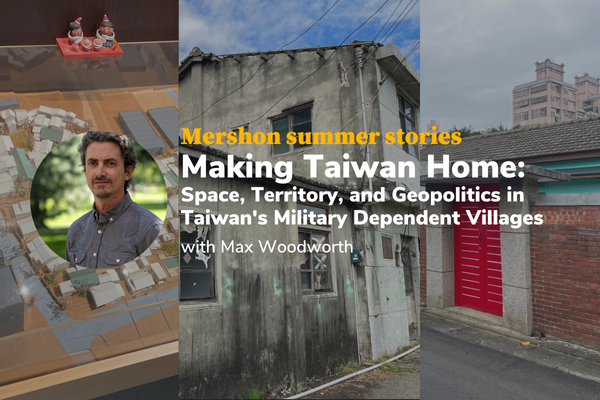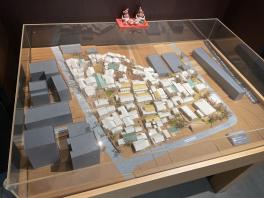Mershon Summer Stories: Max Woodworth - Making Taiwan Home

Mershon's faculty and graduate student grants funded some extraordinary research last summer! This week we highlight the work of associate professor in Geography, Max Woodworth, and his Mershon Center funded project on space, territory, and geopolitics in Taiwan's military dependent villages.

During the summer 2024 term, I spent two weeks conducting fieldwork on Taiwan’s so-called military dependent villages (MDVs). These sites were concentrated residential spaces for active-duty and retired middle- and high-rank officers and their families built from the 1950s through the 1990s. The “village” nomenclature is slightly misleading, as MDVs were not necessarily rural spaces, and their residents were not engaged in agrarian activities. Rather, the “villages” were settlements established to provide improved housing for members of the Republic of China’s military members who joined the retreat to Taiwan in 1949 and either brought families with them to the island or established families in the following years. The decision to construct permanent housing for exiled military units was controversial from the start, as the Chiang Kai-Shek regime insisted that its flight to Taiwan was merely temporary. The Kuomintang official line through the 1970s was that the ROC’s restoration on Mainland China was imminent and would be brought about either by the collapse of Mao Zedong’s Communist regime or by a U.S.-assisted ROC assault. In this context, building permanent homes for exiled troops and their families was not just a waste of scarce resources, it was a tacit admission that the mission to “retake the Mainland” was being abandoned.

In this context, over 800 MDVs were constructed hastily, on shoestring budgets, and in decidedly utilitarian and austere modes. Homes were built in clusters of rows of single-story barracks divided into identical units with three to five rooms, including living space and kitchen. Plumbing, kitchens, and private bathrooms only became commonplace in MDV units in the 1970s and 1980s. Despite their spartan character, MDVs were social spaces that nurtured distinctive exilic micro-societies within their walls.

My research on MDVs has focused on these sites as artifacts of Taiwan’s experience of the global Cold War and its transformation into a multi-party democracy and multi-ethnic, multi-lingual society since 1949. MDVs, according to my research findings, were vital spaces where a critical segment of Mainland-originating exiles in Taiwan became permanently settled on the island and whose subsequent generations have lived Taiwanese society’s transition away from ideological Chinese nationalism toward an as-yet undetermined political-cultural identity rooted in the reduced territory of Taiwan. Residential settlement in MDVs over decades ironically fostered durable ties to Taiwan, even among the ROC’s social group most favorable to unification with the Mainland. Nearly all MDVs have been redeveloped since the 1990s, and only about 30 persist as cultural heritage sites and open-air museums memorializing Taiwan’s post-war decades.

For my fieldwork, I visited MDVs in Yunlin County, Taichung County, Taoyuan County, Hsinchu County, and Taipei, as well archives in Taoyuan and Taipei. I was also able this summer to consult Taiwan studies materials at the University of Washington and University of British Columbia and Simon Fraser University. The materials gathered this summer are helping me to craft a series of essays on MDVs examining the history of their development, their spatial and design components and interior landscapes, current efforts to make MDVs tourist-friendly heritage sites, and the implications of MDVs for the persistent irresolution of the simmering conflict across the Taiwan Strait.
First image is from a military police village in Taoyuan County. The village shows the distinctive low-slung architecture and rudimentary materials typical of MDVs.
Middle image is a scale model of Heart Village in Taipei that shows the small scale of the MDV and its dense clustering of small homes.
Bottom image is from Qingshui Village in Taichung County that houses members of the Air Force and their families. A second floor additions are gradually added floors to their homes as settlement in Taiwan became permanent.
